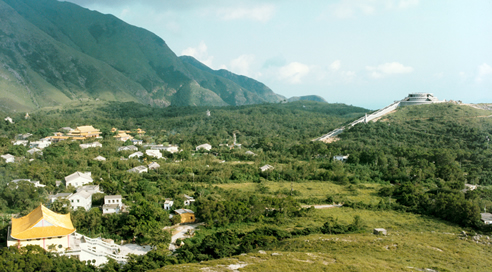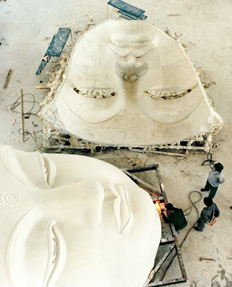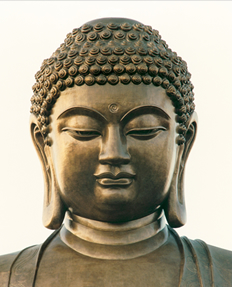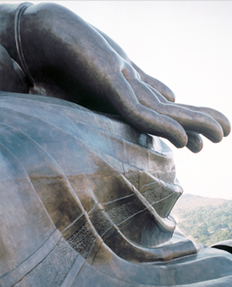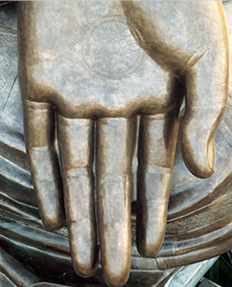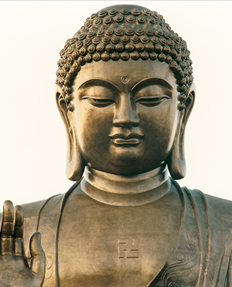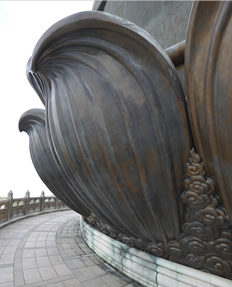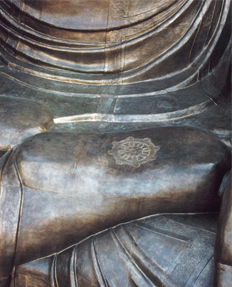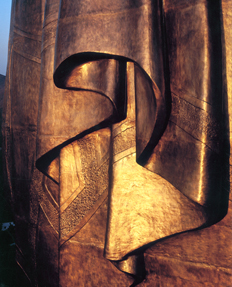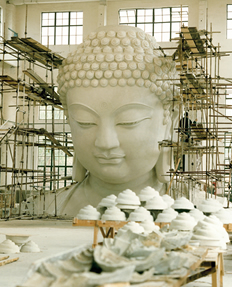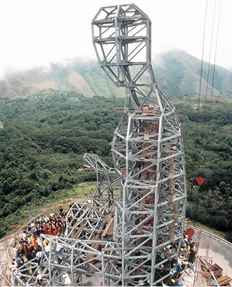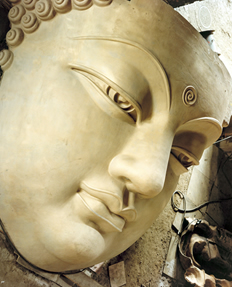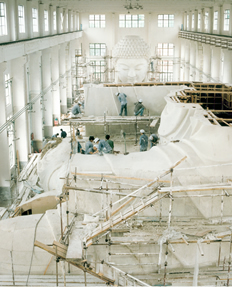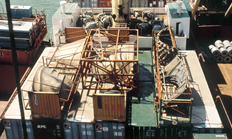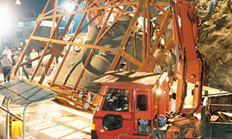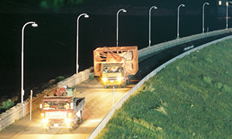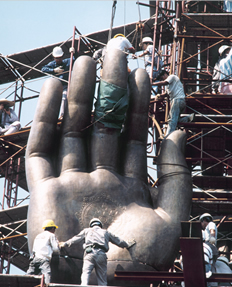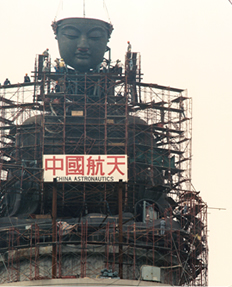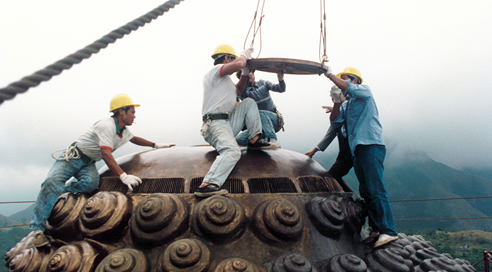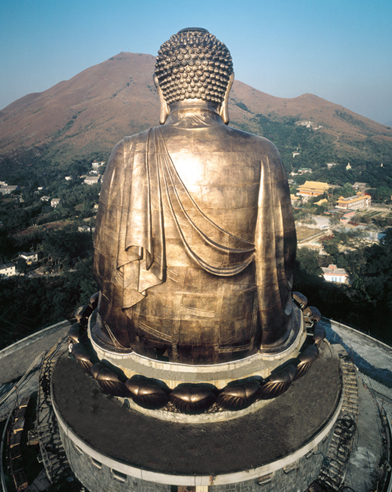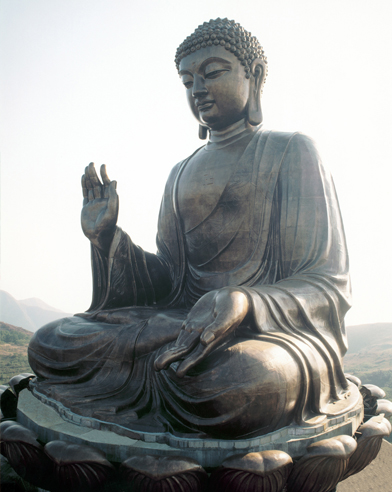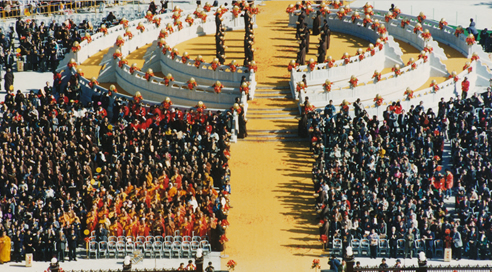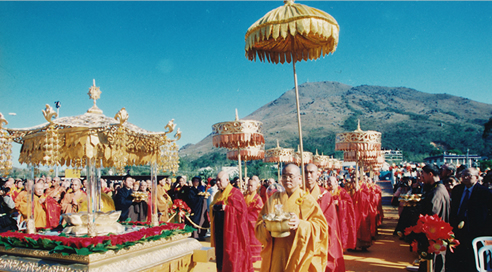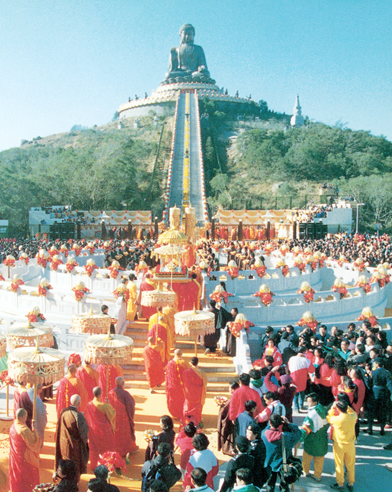
- 掃壹掃,關註微信公眾號

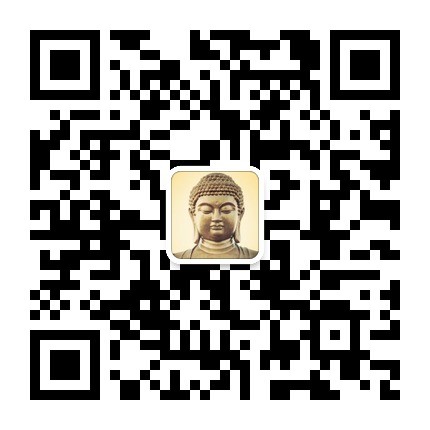
- 請使用微信掃描二維碼關註
- Homepage
- The Big Buddha
- Building the Big Buddha
The Big Buddha on Lantau Island is the biggest sitting Buddha statue built outdoor. This majestic statue sits atop the peak of Mount Muk Yue. Po Lin Monastery has taken 12 years to plan and build this bronze Buddha statue that symbolizes the stability of Hong Kong, prosperity of China and peace on earth.
The Big Buddha Statue has become a major landmark in Hong Kong, attracting numerous local and overseas Buddhists and visitors. It is not only a remarkable work project, but also an outstanding piece in Buddhist sculptural art in recent history. It is a valuable heritage of mankind.
According to Buddhist literature, during the time of the Buddha, King Udayana of Vatsa and King Prasenajit of Kausala in central India missed the Buddha so much that, when the Buddha was preaching to his mother in heaven, they each asked craftsmen to create a 5-foot statue of the Buddha in gosirsa candana and purple gold. This has become the prototype of Buddhist statues. In the ensuing few hundred years, Buddhist followers revered the Buddha principally in the written and spoken languages and had made few statues of him. They believed that the Buddha was a sage with full wisdom, and that his splendor was beyond portrayal. Since no man had ever achieved enlightenment like the Buddhas, no human image could be used to represent him. The faithful only used footprints, the Dharma wheel, the Bodhi tree and the image of deer to symbolize the Buddhas image.
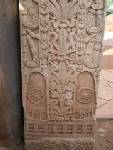
Footprints
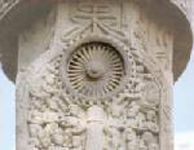
Dharma Wheel
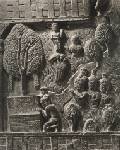
Bodhi Tree
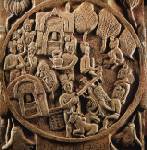
Deer
In the first century AD, some faithful started to advocate paying homage to the Buddha as a way to achieve enlightenment. This marked the emergence of Buddhist statues.
Buddhism was introduced into China during the Eastern Han period (25-220 AD). Together with it came statues of Buddhas, Bodhisattvas, flying apsaras and viras. This prompted the development of religious art in China. In the period from the Northern Wei (386-534 AD) to the Tang and the Song (618-1279 AD) Dynasties, Buddhist arts flourished and reached great heights. During this period, large grotto temples were built and statues sculpted in the Dunhuang, Maijishan, Yungang, Longmen, and Gongxian, as well as in Fowan and Baoding Shan in Daizu county of Sichuan province. The tradition of Buddhist sculptural art was kept up through the ages ever since. Many of the sculptures have been destroyed and damaged by natural disasters or wars over the years, but today when we look at the huge sculptures in Longmen in Luoyang, or Leshan in Sichuan, we can still appreciate and would indeed be overwhelmed by the splendor and magnificence of the religious art of the old times.
Buddhist sculptural art was on the decline since the Ming and Qing Dynasties. Large outdoor Buddhist statues have been rare. A fine tradition of over one thousand years is now almost gone.
In 1973, the Venerable Chi Wai, Venerable Yuen Wai and other monks of Po Lin Monastery were invited for a visit to the Caodong School of Japan. They were greatly impressed by the grandeur and stately Buddha statue of Kamakura. Later, when they visited Taiwan and saw the majestic grand Buddha statue in Zhanghua, they called to mind that at the times when Buddhism flourished, Buddhist statues were always built to symbolize Buddhas image. They also considered adopting the Buddhas image in spreading Buddhist teachings a well worth preserved tradition. They therefore vowed to build a big Buddha statue in Hong Kong; they believed the spirit of tranquility and peace exuded by the Buddhas image a source of spiritual comfort for people: their mind could be purified, their worries allayed and they could reach the state of inner peace.
In 1974, Po Lin Monastery was granted 6,567 square meters of land in Mount Muk Yue by the Government, at a nominal premium, for the building of the Buddha statue.
In 1979, upon the opening up of China, the monks were invited for a visit to Mainland. They had the opportunity of seeing the statues of Longmen and Dunhuang for the first time. Filled with admiration and awe, they were more committed to building a big Buddha statue in Hong Kong. They then visited Tian Tan (Altar of Heaven) in Beijing. As the Buddha was often referred to as a deva of devas and a sage among sages, the idea of building the big Buddha statue on a base platform of a "tian tan" was thus conceptualised. This is how the statue came to be called the Tian Tan Big Buddha Statue.
The concept of building a big Buddha statue received enthusiastic support from various sectors of the community. The Committee for the Construction of the Tian Tan Buddha Statue was formally established, by Po Lin Monastery, on 26 December 1981 to coordinate the project, including the artistic design and concept of the statue, building material, and details of construction.
The design of the statue was based on the 32 laksanas, that is, "physical marks" of the Buddha as described in the sutras. The face was modeled after the Buddha Vairocana of the Longmen Caves for its fullness and serene beauty. The clothes and headgear had their inspiration from the soft and smooth flowing lines of the Buddha Sakyamuni image in Cave 360 of the Dunhuang Grottoes. The statue was therefore a culmination of the characteristics of sculptural art of the Sui and Tang Dynasties when Buddhism was at its prime, skillfully mastered and conceptualised by the artist to shape the perfect design of the Buddha statue that we see today.
The plaster model of the statue was fashioned by Ms Hou Jinhui of the Guangzhou Institute of Fine Arts. She started work in April 1982. The 1:5 scale plaster model was completed in February 1984, the draft of which had been revisited eight times, following discussions and consultations with the artist responsible for the conceptual design of the statue.
Every feature of the Buddha statue has a symbolic meaning of religious significance.
With face like a full moon, a broad forehead, and elongated ears reaching almost to the shoulders, the Buddha is shown to be in full possession of both virtue and wisdom and the embodiment of perfection. His kindly smile fills the hearts of the onlookers with joy. The usnisa pearl and conch hair on the head represent the full wisdom of the Buddha. His green lotus eyes, and his new moon eyebrows, are depicted in soft lines, symbolizing the eyes of compassion with which the Buddha looks on all sentient beings. Between the eyebrows, there is a curl white as snow and soft as cotton which twirls right, signifying that the Buddha is preaching the truth to all beings.
The hands of the Buddha are slender and supple, pliable yet firm. The right hand is in the mudra of "imparting fearlessness", indicating the compassion of the Buddha to save all sentient beings from their sufferings.
The left hand rests on the lap, with the palm turning up and fingers pointing slightly downward. This is called the mudra of "fulfilling wishes", implying the vow to grant blessing and happiness to all.
On each of the palms is a Dharmacakra (wheel of the law) signifying that the Buddha truth is eternal and will spread to the ten directions of the universe.
The Buddha sits cross-legged on the lotus throne, like a lotus which grows out of sludge, symbolizing that the Buddha is pure and without any defilement. He can live in this world of turbidity and save all recalcitrant and unyielding beings. The statue is full bodied and peaceful. The statue is majestic and refined, conveying the Buddhas spirit of compassion, loving kindness and impartiality.
The original idea was to use reinforced concrete for the building of the Buddha statue. However, due to artistic requirements, structural problems, as well as the anticipated difficulties in quality and cost control, bronze was finally chosen as the building material.
The actual casting, finishing and assembly of the Buddha statue were principally carried out in the Nanjing Chengguang Machinery Plant of the China Astronautics Science and Technology Consultant Corporation. The project was divided into six stages.
In the stage of overall project design, over 5,000 drawings and 300 technical documents were produced within less than three months. The daily and monthly work progress for the subsequent three years was mapped out and prepared by system analysis.
The 1:5 scale (about 5 meters high) plaster model of the statue was shipped to Nanjing from Guangzhou on 26 September 1986.
The enlargement was carried out through a special "survey-controlled box enlargement method". That is, the technical staff used stereoscopic photography to find out the position of the statue in space and over 3,900 coordinate points were established. Then the computer was used to calculate the enlargement. At the same time, a traditional method of using boxes which were stacked up in layers was used to form the inner frame of the statue. Then plaster was applied to the outer surface. A 1:1 scale model was thus made.
The body of the statue was to be cast in bronze pieces supported by an inner framework and fixed by connecting bolts. The main framework was made of steel and auxiliary supports were used to connect the bronze pieces to the main frame.
After careful studies and surveying, the whole statue was divided into 202 bronze pieces, the thickness of which ranged from 10 mm to 13 mm. Precision moulds were prepared according to the different shapes of the pieces. The error margin of each piece thus cast was less than 3 mm.
In an effort to portray fully the splendor of Buddha Sakyamuni, and to achieve a perfect artistic design, the professional staff managed to overcome numerous difficulties and finally cast the face of the Buddha in a single piece. The face piece measured 4.3 meters by 5.8 meters. It was 13 mm thick and weight 5 metric tones.
The trial assembly was carried out in the plant rehearsing for the on site assembly. Any problems that might occur on site were detected and solved in the plant.
The Buddha statue was trial assembled separately in three sections, the upper, the middle and the lower sections. Various necessary adjustments and trimmings were made to the bronze pieces. Initial mechanical finishing was also carried out.
The bronze pieces were transported to Hong Kong by sea in April 1989. As the face of the statue was very large and the roads on Lantau Island were winding and narrow, there were acute technical problems in transporting the face piece up to Mount Muk Yue.
With the help of the Transport Department and with careful arrangements, the face piece and two other large bronze pieces were at last safely transported to the site. A large lorry and two large cranes, sandwiching the lorry in the middle, were used in the whole journey for this arduous work.
The assembly and welding of the statue were carried out from bottom upwards in eight layers. The length of weld was over 5 kilometers. As all the work had to be carried out in open air, one could well imagine how arduous the task was.
To ensure that the Buddha statue would not be damaged by strong winds, the specialists had conducted calculations on the wind pressure, imposed load and material strength of the various parts of the statue by computer. The Beijing Institute of Aerodynamics had specially created a testing model, utilizing the wind tunnel employed for satellites and rockets to conduct wind tests on the statue as a whole, on the various parts, unidirectional as well as multidirectional.
The surface colouring of the statue had been studied carefully for over a year. The optimal coating was selected from various formulae for surface colouring, which oozes an air of classical simplicity and solemn dignity, and is not susceptible to fading because of corrosion due to the exposure to the elements.
On 13 October 1989, the last bronze piece of the statue was put in place and a solemn topping ceremony was held on the same day. The Big Buddha Statue, the making of which had taken three years, was the impeccable joint effort and dedicated hard work of the faithful, the Buddhist order, and the artists, artificers and professionals.
The inaugural ceremony of the Big Buddha was held on 29 December 1993.
The Big Buddha Statue was elected as the fourth of the 10 Engineering Wonders in Hong Kong in 2000. The top three were all public works projects, the first being the Lantau Link, the second, the Hong Kong International Airport Passenger Terminal, and the third, the Hong Kong Convention and Exhibition Centre Extension. Of the projects in the private sector, the Big Buddha Stature came as the first.
The Big Buddha Statue is the culmination of Buddhist sculptural art of the old and of the contemporary. It combines traditional bronze art with modern science and technology and embodies the harmonious resonance of Buddhist spirit and modern civilization – a solemn epitome of human beings continuous and unyielding pursuit of moral happiness and peace on earth.
